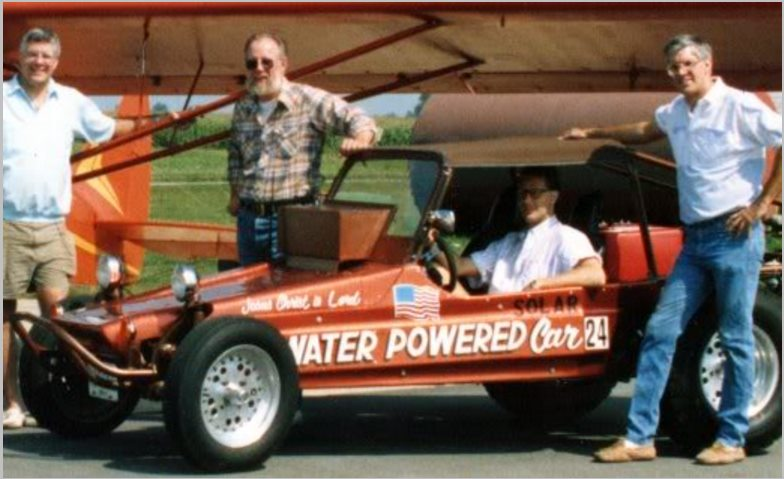Is Grove City Inventor Stan Meyer for real? - January 25th, 1990
By Marcia Thompson
January 25th, 1990
Source: https://grovecity.advantage-preservation.com/viewer/?k=&t=30203&i=t&d=01011901-12312011&m=between&ord=k1&fn=the_grove_city_record_usa_ohio_grove_city_19900125_english_4&df=21&dt=30
 Is Stan Meyer for real? Or is he some crazy Utopian-eyed idealist who doesn’t have a real grip on reality? As far as I’m concerned, Stan Meyer is for real. He is a live, flesh-and-blood man who claims he is getting gray hairs sooner than he should be as he fulfills a "divine" mission—creating a technology and related systems which would allow cars, trucks, planes, and ships to run on small amounts of any kind of water, as well as home heating systems, grain dryers, and much more, thus eliminating the world’s dependency on our ever-decreasing oil supplies and reducing the much-publicized "greenhouse effect" plaguing the world.
Is Stan Meyer for real? Or is he some crazy Utopian-eyed idealist who doesn’t have a real grip on reality? As far as I’m concerned, Stan Meyer is for real. He is a live, flesh-and-blood man who claims he is getting gray hairs sooner than he should be as he fulfills a "divine" mission—creating a technology and related systems which would allow cars, trucks, planes, and ships to run on small amounts of any kind of water, as well as home heating systems, grain dryers, and much more, thus eliminating the world’s dependency on our ever-decreasing oil supplies and reducing the much-publicized "greenhouse effect" plaguing the world.
Revolutionary idea? You bet. Is it really something that can be achieved? From all indications, it seems highly likely.
The Grove City Record, Meyer’s hometown newspaper, first ran a copyrighted story about his invention in 1985, written by Editor Shannon Hamons. Follow-up stories have chronicled events as they have occurred since then, including a public unveiling of the buggy using water as fuel on October 11, 1986.
So, four years have passed and why haven’t we seen the dune buggy flitting around Grove City more? Meyer says that inventing is a complete process—including the technology as well as the engineering plans—it’s not something that can be completed overnight. Too many other inventors of world-shaking inventions have disappeared from sight and lost their rights to their own inventions as they’ve been either bought out or squelched in further development.
Learning from them, Meyer has protected himself and his revolutionary process for water fuel by legalizing all paperwork, filing patents on every part of his technology, and now by patenting all the designs—before anything is made public.
Meyer claims it’s been an up-hill battle all the way. There are many industries, countries, and individuals out there who would like to make sure his ideas never get past the drawing board—oil companies, the auto industry, countries whose economies revolve around oil profits, and others who stand to gain by keeping the new energy system off the market. By covering himself technically and legally every step of the way, he’s trying to make sure that his invention won’t be blocked from coming out on the marketplace. His life has been threatened, but he says that even if something should happen to him, he’s made sure the Water Fuel Cell technology will still be developed.
Because I’ve written articles and news releases since 1986 about Meyer, I get calls occasionally from all over the United States, as well as some inquiries from abroad, about him and what he’s doing. I’m not always able to answer everyone’s questions about the technical aspects of the invention. I’m not a scientist or engineer, and when I talk to Stan Meyer, it takes a lot of concentration on my part to follow along on his path to "free energy." I understand what he is trying to achieve, but sometimes the technical jargon slips off his tongue easily. Processes he’s describing like they’re mundane, everyday things to him seem like Greek to me. I’m learning, though… all the time.
I’m sometimes asked if I’ve "seen" anything or "read" anything that indicates that Meyer’s invention will really work. Well, our former editor Shannon Hamons witnessed the actual running of the car, and I’ve seen tapes of that event. I’ve seen the dune buggy (and I’m anxiously awaiting my first ride in it). I’ve seen the parts that have been invented by Meyer that allow the system to work, and I’ve seen tapes of actual testing of some of the complex circuitry during which the dune buggy is actually running. I’ve had access to some of his drawings and technical briefs and texts. However, I don’t always completely understand or maybe realize the significance of what I’m seeing or reading, and none of this proves that one of these days we’ll all be using water instead of gasoline in our cars, for example. What it does prove to me is that work is ongoing and Meyer is dedicated to his mission and is sincere in his belief that he’s on the right track to solving the world’s energy crisis problems.
There’s a very real possibility that this future—Grove City may be known worldwide as the birthplace of the Water Fuel Cell system, in the not-too-distant future. And if life as we know it will never be the same again.
